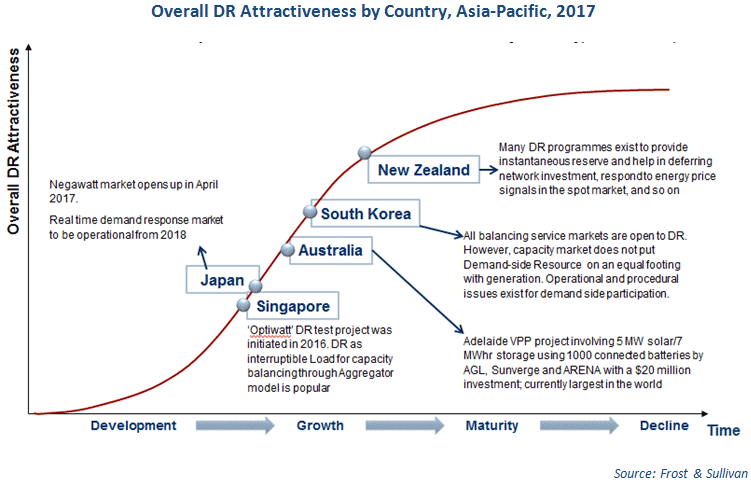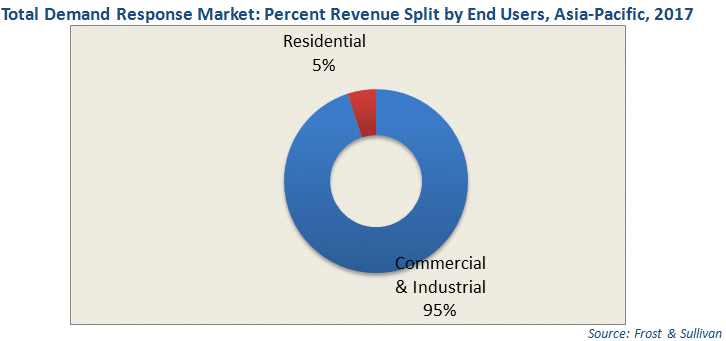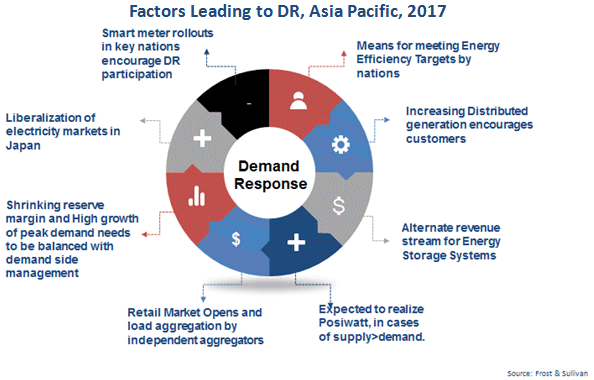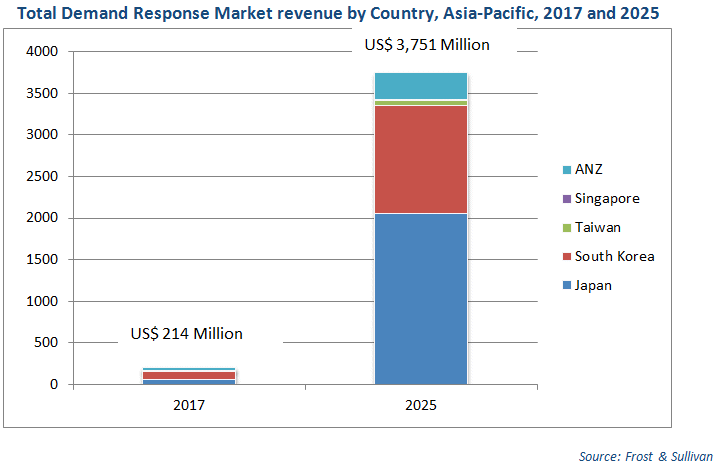According to the International Energy Agency, “Demand response (DR) refers to a set of strategies which aim to bring the demand-side of the electricity market back into the price-setting process. Demand-side resources are variable loads created as customers adjust their demand in response to price signals.’’ Managing energy use through DR programs has been in existence in one form or the other over the last two decades. Monetary incentives and cost-savings option by curtailing power usage during peak demand period have been available for commercial and industrial (C&I) customers since 2002.
Globally, the DR market was estimated at $2.67 billion in 2017, and the Asia-Pacific region contributed approximately 8% of it.

These countries have set energy efficiency targets to be met by 2030. Japan aims to reduce its energy intensity by 30% (from its 2012 values), Taiwan by 33% and South Korea aims to reduce 55 Mtoe of energy by 2035. DR is expected to save millions by deferring investments on peak power generation plants to support electricity demand. Commercial and industrial (C&I) are the most attractive sectors for DR implementation as they are highly energy intensive in nature, compared to the residential segment.

DR programs can be classified into two main categories, namely –
- Price-Based Programs (PBP) in which consumers choose to be exposed to time-varying electricity prices that reflect cost of electricity during different time of day.
- Incentive-Based Programs (IBP) entails pre-contracted agreement with a customer for a specified amount of load and compensation.
The price based DR programs are yet to be popularized in these markets. Incentive based DR at pre contracted agreement with a customer is undertaken in the region. Time-of-Use pricing and Critical Peak pricing programs can be expected in the next 3-5 years.

Driving Factors for DR Adoption
Increasing coal and gas prices, emission constraints on coal, and inadequate gas supply have resulted in an increase in electricity cost in the region during past 5 years. This is a key driver for DR programs, so as to avoid massive payments during peak demand periods.
A liberalized electricity sector with an active wholesale electricity market is important for private sector participation in DR aggregation and demand bids. In Japan, the electricity retail sector was liberalized in 2016. In Singapore, liberalization of electricity sector has encouraged capacity demand response.These markets have opened up for demand response, and DR aggregators have accumulated DR resources worth 165 MW in Japan and 7.2 MW in Singapore till date.
Distributed generation (DG) through solar and wind and battery based energy storage systems is acquiring importance in Asia-Pacific, especially Japan, South Korea, and Australia. DG ensures grid independence and it encourages participation in demand response. Besides, there are government funds allocated to encourage distributed generation in these three nations.
Smart meter rollouts: Japan, Australia, South Korea, and Singapore have wide spread smart meter roll-outs. This is a key factor supporting DR operations. While Commercial & Industrial smart-meter roll-outs were completed in most of these countries, residential installations are in progress, and expected to be complete between 2022 and 2024.

DR Developments across Asia-Pacific
Asia-Pacific has a growing DR market, with South Korea leading the path with 3.88 GW in 2017. According to Korea Power Exchange (KPX), the ‘negawatt market’ has 14 DR Service providers who have accumulated a total of 2,233 customers from various C&I customers. KPX operates a day ahead economic feasibility DR and an hour ahead reliability-based DR. Korea Electric Power Corporation (KEPCO) aims to accumulate DR resources of 6.8 GW by 2020 and 12 GW by 2023.
In Japan, four electric companies are actively aggregating DR resources of C&I customers, which added to 958 MW in 2017. Two types of DR in the market are- (1)Auto Demand response-which is at a higher price and initiated without notifying customers, (2)Best effort DR, which is initiated by customers and maximum load is shed at best effort basis. By 2020, the DR market is expected to open up under Japan Power Exchange to trade demand response for ancillary services. By then, aggregated resources would rise above 9 GW.
Australian Electricity Market Operator (AEMO) runs the DR for Emergency Reserve project which operated 600 MW of Aggregated DR during December to February 2017-18. This is expected to grow annually between 10% and 15%. AEMO and Australian Renewable Energy Agency (ARENA) started a DR research project in 2017, for resources of 200 MW. The project aggregates resources from residential and C&I customers to study the feasibility of DR in the market. Currently, AEMO restricts private parties from entering DR aggregation; only electricity retailers or distribution operators can perform DR aggregation. A change in this scenario through a regulation can be expected by 2020 and is likely to be a key driver for its growth beyond 2020.
Taipower Company (TPC), the electrical utility in Taiwan aggregated 671 MW of DR resources during the peak summer of 2016. Their reserve margin dropped below 5% in 2014, this has prompted the utility to gear up demand response programs. DR units are contracted for 15 min spans at TPC. Apart from these programs, TPC also operates emergency curtailment program and scheduled load reduction programs.
Singapore is the major market for demand response in Southeast Asia. Singapore Power initiated the ‘Optiwatt’ project (2016-2020), a trial project to study the feasibility of DR in the country. In 2017, 7.2 MW of DR resources was aggregated from C&I customers, under Interruptible load scheme (emergency DR). Currently, the peak and off-peak electricity price differences in the country are not significant enough to encourage customers in DR participation. It is expected that with the influx of rooftop solar and opening up of retail market for customers with demand less than 2 kW, the DR market is likely to grow above 50 MW by 2020.
Path Ahead for DR
- Emergency DR constitutes majority (approximately 70%) of the total DR market. Japan, Australia, and Singapore markets operate primarily in this model. Implicit DR pricing models can be expected to become popular during the next 5 years.
- Residential DR is being popularized in NZ, and test- trialled in Japan and Australia. The rollout of residential smart meters was crucial; however, smart home appliances and their interoperability with HEMS will be crucial for proper effective DR operation.
- With the integration of more resources under DR aggregation model, Cloud based DR or SaaS model is expected to become popular. This would make the integration of residential resources to the cloud much easier. Besides, several energy intelligent devices are expected to flood the market as residential sector starts participation, the SaaS interoperability with these appliances will be crucial.
- In Japan and Australia where rooftop solar PV is growing rapidly, Posiwatt or reverse DR is likely to be practiced to balanced excess energy against DR load. However, the economic feasibility of this model is yet to be studied in detail.
- DR emerges as a secondary revenue model for Energy Storage Systems, which were installed for power quality improvement, RE fluctuation mitigation and so on.
To conclude, Asia-Pacific region is taking baby-steps in the DR space in comparison to the pace at which the North American market is growing. However, once the test trials in various countries yield results, a full-fledged DR market can be expected in most of these countries by the wake of the next decade.
Frost & Sullivan is currently undertaking a study on ‘Growth Opportunities in the Asia Pacific Demand Response Market’ which is due for publication in June 2018. For any queries on this study please contact [email protected]



